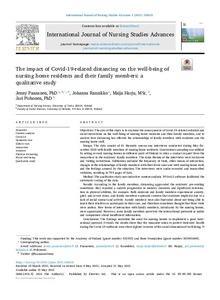The impact of Covid-19-related distancing on the well-being of nursing home residents and their family members: a qualitative study
Paananen Jenny; Rannikko Johanna; Harju Maija; Pirhonen Jari
https://urn.fi/URN:NBN:fi-fe2021093048392
Tiivistelmä
Objectives: The aim of this study is to examine the
consequences of Covid-19-related isolation and social restrictions on
the well-being of nursing home residents and their family members, and
to analyze how distancing has affected the relationships of family
members with residents and the nursing home staff.
Design:
The data consist of 41 thematic one-on-one interviews conducted during
May–December 2020 with family members of nursing home residents.
Convenience sampling was utilized by asking several nursing homes in
different parts of Finland to relay a contact request from the
researchers to the residents’ family members. The main themes of the
interviews were lockdown and visiting restrictions. Subthemes included
the frequency of visits, other means of interaction, changes in the
relationships of family members with their loved ones and with nursing
home staff, and the feelings aroused by the situation. The interviews
were audio recorded and transcribed verbatim, resulting in 794 pages of
data.
Method: The qualitative study uses inductive content analysis. NVivo12 software facilitated the systematic coding of the data.
Results:
According to the family members, distancing aggravated the residents’
pre-existing conditions: they reported a sudden progression in memory
disorders and significant deterioration in physical abilities, for
example. Both residents and family members experienced anxiety, grief,
and severe stress, and family members expressed concern that residents
might die due to a lack of social contact and activity. Family members
were also frustrated about not being able to touch their relatives or
participate in their care, and therefore sometimes thought that their
visits were useless. New forms of interaction with family members,
introduced by the nursing homes, were appreciated. However, some family
members perceived the interactional protocols as unfair and complained
about insufficient information.
Conclusions: The
findings underline the need for nursing homes to implement a good
interactional protocol. Overall, the results show that the measures
taken to protect residents’ health during the Covid-19 outbreak were
short-sighted in terms of the social dimension of well-being. It is
therefore important to continue developing safe and humane solutions for
interaction when social restrictions are in place.
Kokoelmat
- Rinnakkaistallenteet [27094]
